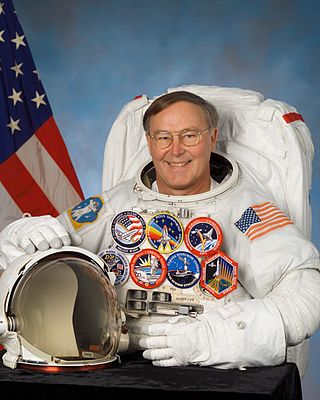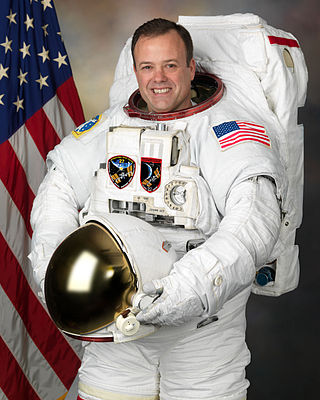
John Howard Casper is a former American astronaut and retired United States Air Force pilot.

Michael John "Bloomer" Bloomfield is an American former astronaut and a veteran of three Space Shuttle missions.

Jerry Lynn Ross is a retired United States Air Force officer, engineer, and a former NASA astronaut. Ross is a veteran of 7 Space Shuttle missions, making him the joint record holder for most spaceflights.

STS-51-C was the 15th flight of NASA's Space Shuttle program, and the third flight of Space Shuttle Discovery. It launched on January 24, 1985, and made the fourth shuttle landing at Kennedy Space Center, Florida, on January 27, 1985. STS-51-C was the first shuttle mission to deploy a dedicated United States Department of Defense (DoD) payload, and consequently many mission details remain classified.

Henry Warren Hartsfield Jr. was a United States Air Force Colonel and NASA astronaut who logged over 480 hours in space. He was inducted into the United States Astronaut Hall of Fame in 2006.

Richard Oswalt Covey is a retired United States Air Force officer, former NASA astronaut, and a member of the United States Astronaut Hall of Fame.

John McCreary Fabian is a former NASA astronaut and Air Force officer who flew two Space Shuttle missions and worked on the development of the Shuttle's robotic arm. He later led the Air Force's space operations.

John Elmer Blaha is a retired United States Air Force colonel and a former NASA astronaut. He is a veteran of five space missions aboard the Space Shuttle and Mir.

Roy Dubard Bridges Jr. is an American pilot, engineer, retired United States Air Force officer, test pilot, former NASA astronaut and the former director of NASA's John F. Kennedy Space Center and Langley Research Center. As a command pilot, he has over 4,460 flying hours, and is a decorated veteran of 262 combat missions during the Vietnam War. He retired as a U.S. Air Force major general, last serving as the Director of Requirements, Headquarters Air Force Materiel Command, Wright-Patterson Air Force Base, Ohio, from June 1993 until his retirement. He is married with two adult children.

Lloyd Blaine Hammond Jr. is a Gulfstream test pilot, a former United States Air Force officer, and a former NASA astronaut. He flew on two Space Shuttle missions.

Guy Spence Gardner is a United States Air Force officer and a former astronaut. He holds the rank of colonel. He flew as pilot on two Space Shuttle missions, STS-27 and STS-35. Gardner was also the 12th president of the Williamson College of the Trades.

Steven Wayne Lindsey is a retired U.S. Air Force officer and NASA astronaut. Lindsey served as Chief of the NASA Astronaut Office from September 2006 until October 2009.

Donald Ray McMonagle is a former astronaut and a veteran of three shuttle flights. He became the Manager, Launch Integration, at the Kennedy Space Center, Florida, on August 15, 1997. In this capacity he was responsible for final shuttle preparation, launch execution, and return of the orbiter to KSC following landings at any other location. He was chair of the Mission Management Team, and was the final authority for launch decision.

Mark Lewis "Roman" Polansky is an American aerospace engineer and research pilot and a former NASA astronaut. Polansky received the nickname "Roman" as a joke, because he shares a last name with director Roman Polanski. He flew on three Space Shuttle missions: STS-98, STS-116, and STS-127 and was first person of Korean ancestry in space.

Rex Joseph Walheim is a retired United States Air Force officer, engineer and NASA astronaut. He flew three Space Shuttle missions, STS-110, STS-122, and STS-135. Walheim logged over 566 hours in space, including 36 hours and 23 minutes of spacewalk (EVA) time. He was assigned as mission specialist and flight engineer on STS-135, the final Space Shuttle mission.

James Patrick "Mash" Dutton, Jr. is an engineer, former NASA astronaut pilot of the Class of 2004, and a former test pilot in the US Air Force with the rank of colonel.

Eric Allen Boe is a retired United States Air Force fighter pilot, Colonel, test pilot, and a current, active NASA astronaut. He flew as the pilot of Space Shuttle missions STS-126 and STS-133.

Ronald John Garan Jr. is a retired NASA astronaut. After graduating from State University of New York College at Oneonta in 1982, he joined the Air Force, becoming a Second Lieutenant in 1984. He became an F-16 pilot, and flew combat missions in Desert Shield and Desert Storm. Before becoming an astronaut he was the Operations Officer of the 40th Flight Test Squadron (FTS). He first flew in space as a mission specialist on the May 2008 STS-124 mission to the International Space Station (ISS). He returned to ISS on April 4, 2011, for a six-month stay as a member of Expedition 27. Garan is a highly decorated former NASA astronaut who flew on the US Space Shuttle, Russian Soyuz, and International Space Station. In total he spent 178 days in space and more than 71 million miles in 2,842 orbits of Earth, 27 hours and 3 minutes of EVA in four spacewalks, and 18 days on the bottom of the ocean during the NEEMO-9 undersea mission.

Benjamin Alvin Drew is a United States Air Force officer and a former NASA astronaut. He has been on two spaceflights; the first was the Space Shuttle mission STS-118 to the International Space Station, in August 2007. Drew's second spaceflight took place in March 2011 on STS-133, another mission to the International Space Station. STS-133 was Space Shuttle Discovery's final mission. Drew took part in two spacewalks while docked to the station. Drew was the final African-American to fly on board a Space Shuttle, as the final two Space Shuttle missions, STS-134 and STS-135, had no African-American crew members.
The Manned Spaceflight Engineer Program was an effort by the United States Air Force to train American military personnel as payload specialists for United States Department of Defense missions on the Space Shuttle program.



















